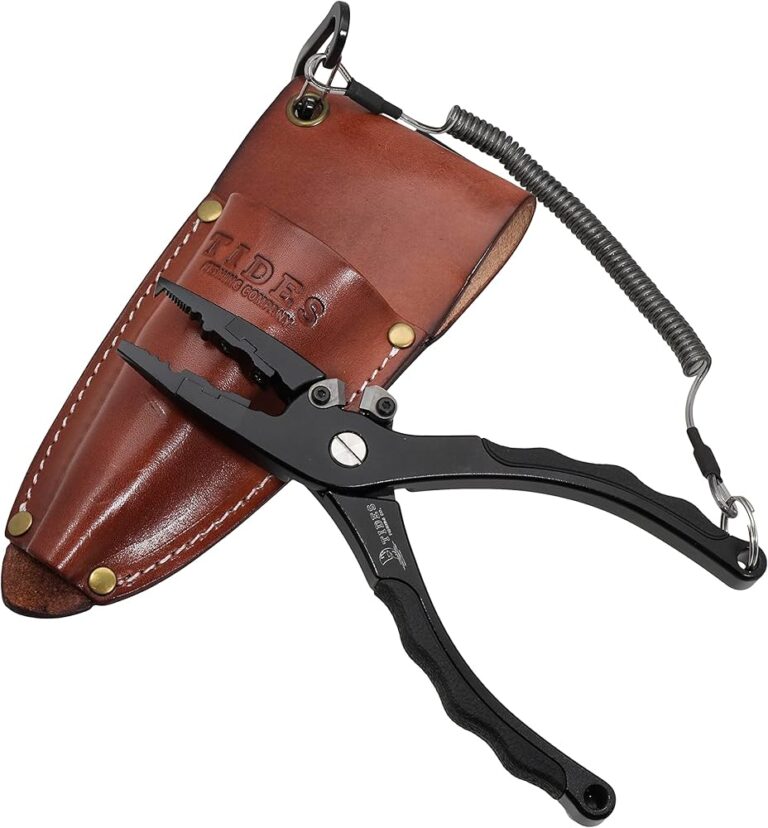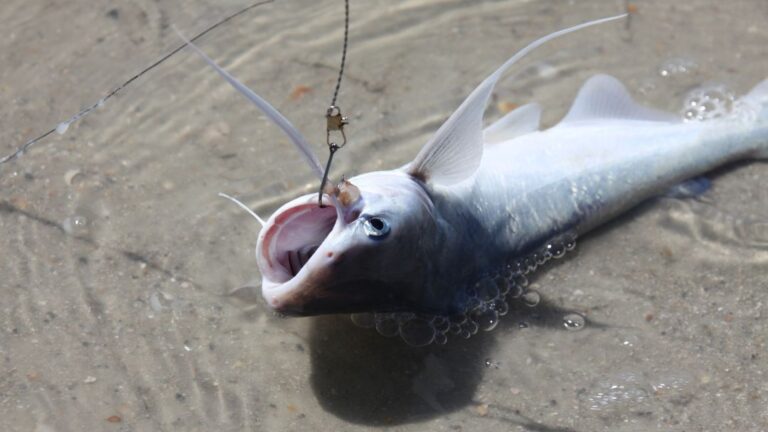Easy to Intermediate Fishing Loop Knots: Master Essential Skills!
Learn easy to intermediate fishing loop knots in just two sentences. These versatile knots are essential for connecting fishing lines and attaching hooks, lures, or swivels securely.
Master these knots to enhance your fishing skills and increase your chances of success. Fishing loop knots are indispensable for any angler, enabling them to connect fishing lines and fasten hooks, lures, or swivels with utmost security. By mastering these easy to intermediate knots, you can significantly enhance your fishing abilities and boost your success on the water.
Whether you’re a novice or experienced angler, these essential knots will prove invaluable in your pursuit of the perfect catch.
Introduction To Fishing Loop Knots
In the world of fishing, the type of knot you use can make all the difference. One particular type of knot that every angler should have in their repertoire is the loop knot. Loop knots not only offer strength and reliability, but they also provide a versatile and efficient way of attaching your line to hooks, lures, or swivels.
Importance Of Loop Knots In Fishing
Loop knots play a crucial role in fishing and can make a significant impact on your success on the water. Whether you’re targeting freshwater species like bass or trout or exploring the depths of the ocean for saltwater game fish, using loop knots can give you a competitive advantage.
- Strong and secure: Loop knots are known for their strength and stability, especially when compared to other knots like the traditional clinch knot. This means you can have peace of mind knowing that your knot won’t come undone when battling with a hard-fighting fish.
- Easy lure action: One of the primary benefits of using loop knots is that they allow your lures to move more freely in the water. Without the restriction of a tight knot, your bait or lure can imitate natural movements, increasing its chances of attracting nearby fish.
- Less line twist: Loop knots also minimize the likelihood of line twist, a common problem that can reduce casting distance and affect the presentation of your bait. By creating a smooth and unrestricted connection point, loop knots help keep your line from becoming tangled or twisted during retrieval.
- Quick and efficient: Another advantage of loop knots is their simplicity and ease of tying. Once you’ve mastered the technique, you can tie loop knots quickly, saving you valuable time on the water. This efficiency is particularly vital when you need to change lures frequently or adjust your rigging for different fishing conditions.
How Loop Knots Enhance Fishing Efficiency
Achieving fishing efficiency is every angler’s goal, and loop knots are an essential tool in achieving that goal. Let’s explore how these knots enhance your fishing experience:
- Improved bait action: By allowing your bait to move naturally, loop knots enhance its action in the water. This can be particularly beneficial when using soft plastic baits or live bait, as it helps create a lifelike presentation that fish find irresistible.
- Increased hook-up rates: Loop knots give your bait or lure more freedom to move, ensuring it can entice more strikes and increase your hook-up rates. With a secure loop knot in place, you can expect better penetration and less chance of the fish shaking the hook loose during the fight.
- Flexible rigs: Loop knots provide versatility in rigging options. Whether you prefer to use a loop-to-loop connection, attach a dropper loop, or create a loop on your leader for easy lure changes, loop knots allow you to adapt your setup to different fishing scenarios.
- Confidence in your knot: Knowing you’ve tied a reliable and strong loop knot adds a layer of confidence to your fishing. Trusting in your knot’s ability to withstand the pressure of powerful fish can help you focus more on your technique and increase your chances of success.
The Perfection Loop: Mastering The Versatile Knot
The Perfection Loop: Mastering the Versatile Knot
The perfection loop knot is a popular and versatile knot used by fishermen of all skill levels, from beginners to experienced anglers. It is known for its simplicity and reliability, making it a go-to choice for many fishing applications. Whether you are targeting freshwater or saltwater species, the perfection loop knot can provide the strength and security needed to land your catch.
Step-by-step Guide To Tying The Perfection Loop
Tying the perfection loop knot may seem daunting at first, but with a little practice, you’ll master it in no time. Follow these simple steps to tie the perfection loop knot:
- Start by forming a small loop, leaving enough tag end to work with.
- Next, take the tag end and make a simple overhand knot around the standing line, passing through the loop.
- Pass the tag end through the loop a second time.
- Moisten the knot with saliva or water to lubricate it.
- Tighten the knot by pulling both the standing line and the tag end simultaneously.
- Trim any excess tag end, leaving a neat and secure perfection loop.
Applications And Advantages Of The Perfection Loop Knot
The perfection loop knot has a wide range of applications in fishing, making it an essential skill for any angler. Its versatility allows for various uses, such as:
- Attaching a fly or lure to the leader or tippet line.
- Creating a loop for a dropper fly or adding a tag end for additional flies.
- Securing a loop at the end of the line, making it easy to connect to swivels, snaps, or other terminal tackle.
The advantages of the perfection loop knot are numerous. Not only does it provide a strong and secure connection, but it also retains most of the line’s strength, ensuring your tackle performs optimally. Additionally, the loop created by this knot allows for improved fly action, providing a more natural presentation that can entice even the most finicky fish.
Tips And Tricks For Using The Perfection Loop Knot Effectively
To maximize the effectiveness of the perfection loop knot, consider the following tips and tricks:
- Practice tying the knot before hitting the water to ensure confidence and efficiency in tying it when needed.
- Moisten the knot before tightening to reduce friction and prevent heat build-up, which can weaken the line.
- Leave a slightly longer tag end when tying the knot, as it can provide a better grip when tightening.
- Ensure the loop is properly formed and does not overlap or twist, as this can weaken the knot’s strength.
- Regularly inspect the knot for any signs of damage or wear, as this can compromise its reliability.
By mastering the perfection loop knot and following these tips, you can have confidence in your fishing setup, knowing that your knots are strong and secure. Experiment with different applications and techniques to discover the versatility and effectiveness that the perfection loop knot offers.
The Surgeon’s Loop: An Essential Knot For Attaching Tippets
Understanding the Purpose of the Surgeon’s Loop Knot
The Surgeon’s Loop knot is an essential fishing knot that is commonly used to attach tippets to the main line. It is a strong and reliable knot that provides excellent strength and durability when connecting tippets to the leader. This knot is particularly useful for fly fishing, where the tippet material is thin and delicate.
Detailed Instructions on Tying the Surgeon’s Loop Knot
Follow these step-by-step instructions to tie the Surgeon’s Loop knot:
- Form a simple overhand knot by crossing the end of the line over the main line and pass it through the loop.
- Make another overhand knot in the same manner, creating a double overhand knot.
- Moisten the knots and pull them tight together, ensuring that they are snugly wrapped around the main line.
- Trim off any excess line, leaving a small tag end for added security.
Common Mistakes to Avoid When Tying the Surgeon’s Loop Knot
When tying the Surgeon’s Loop knot, it’s important to avoid these common mistakes:
- Using an improper tag end length: Make sure to leave a tag end of about 3-5 inches for better strength and security. If the tag end is too short, it may slip out of the knot.
- Failure to moisten the knots: Moistening the knots before pulling them tight helps reduce friction, making it easier to tighten the knot properly. It also improves the overall strength of the knot.
- Not tightening the knots properly: Ensure that both overhand knots are pulled tightly together, snugly wrapped around the main line. Loose knots may cause the Surgeon’s Loop to slip or fail under pressure.
- Trimming excess line too closely: Leave a small tag end after tightening the knots to provide additional security. Cutting the excess line too closely may result in an unstable knot.
The Double Surgeon’s Loop: Creating A Durable Connection
In the world of fishing, having a reliable knot that can withstand the pressure of reeling in a big catch is essential. The Double Surgeon’s Loop is a knot that meets this requirement and enables you to create a durable connection between your fishing line and various tackle. Whether you are a beginner or an intermediate angler, mastering this knot will give you the confidence to tackle a wide range of fishing scenarios.
Overview And Benefits Of The Double Surgeon’s Loop Knot
The Double Surgeon’s Loop is known for its simplicity and strength, making it a popular knot choice amongst anglers. This knot is a variation of the Surgeon’s Loop, which is a simple knot used to create a non-slipping loop at the end of a line. The Double Surgeon’s Loop takes this concept a step further by adding an extra twist, resulting in a more secure and reliable connection.
The main benefits of the Double Surgeon’s Loop knot include:
- Strength: The extra twist of the Double Surgeon’s Loop creates additional friction, making it highly resistant to slippage and providing a strong connection that can withstand the force of a fighting fish.
- Simplicity: This knot is easy to tie, even for beginners. With a little practice, you can quickly master the steps and tie the Double Surgeon’s Loop effortlessly.
- Versatility: The Double Surgeon’s Loop can be used to attach various types of tackle, including hooks, lures, and swivels, to your fishing line. It’s a versatile knot that you can rely on in a wide range of fishing scenarios.
Step-by-step Process For Tying The Double Surgeon’s Loop Knot
Follow these simple steps to tie the Double Surgeon’s Loop knot:
- Double your fishing line and create a loop, ensuring that the doubled line is of the desired length for your loop.
- Hold the loop with one hand, forming a simple overhand knot by passing the doubled line through the loop.
- Repeat step 2 by passing the doubled line through the loop one more time, creating a second overhand knot.
- Moisten the knot and pull both ends of the line in opposite directions to tighten the knot evenly.
- Trim the excess line close to the knot, leaving a small tag end.
With these easy-to-follow steps, you can tie a strong and reliable Double Surgeon’s Loop knot, ready to tackle any fishing challenge.
Practical Uses And Scenarios For The Double Surgeon’s Loop Knot
The Double Surgeon’s Loop knot has practical uses in various fishing scenarios. Here are a few examples:
| Use Case | Description |
|---|---|
| Attaching Hooks | Use the Double Surgeon’s Loop to securely attach hooks to your line, ensuring they won’t easily slip or come undone during the fight to land a fish. |
| Adding Lures | When attaching lures, the Double Surgeon’s Loop provides a strong connection that can handle the movements and jerks of the lure without fail. |
| Connecting Swivels | Use the Double Surgeon’s Loop to connect swivels to your line, maintaining their freedom of movement and preventing the line from getting twisted. |
These are just a few examples of how the Double Surgeon’s Loop knot can be utilized in practical fishing scenarios. Its strength and simplicity make it a go-to choice for anglers looking for a reliable and durable connection.
The Loop-to-loop Connection: Joining Lines With Ease
The loop-to-loop connection is a tried and tested method for joining fishing lines with ease. Whether you are a beginner or an experienced angler, mastering this knot will enhance your fishing experience. In this post, we will dive into the concept and advantages of the loop-to-loop connection, provide you with a step-by-step guide for creating this connection, and give you some valuable tips to ensure a secure and streamlined connection every time.
Explaining The Concept And Advantages Of The Loop-to-loop Connection
The loop-to-loop connection is all about simplicity and versatility. It involves creating a loop in one fishing line and attaching it to the loop of another line. This method offers several advantages over other types of knots:
- Ease of use: The loop-to-loop connection is relatively easy to tie and can be quickly mastered with practice.
- Quick line changes: By using the loop-to-loop connection, you can easily switch between different types of fishing lines, such as monofilament, fluorocarbon, and braided lines, without the need for retying knots.
- Strength and flexibility: The loop-to-loop connection maintains the strength and flexibility of the fishing lines, ensuring optimal performance during fishing.
Step-by-step Guide For Creating A Loop-to-loop Connection
Follow these steps to create a secure loop-to-loop connection:
- Step 1: Take the end of one fishing line and form a loop by doubling the line back on itself.
- Step 2: Pass the doubled line through the loop, creating another loop.
- Step 3: Repeat the same process with the other fishing line, creating a loop in the end.
- Step 4: Align the two loops and pass one loop through the other.
- Step 5: Moisten the loops and gradually pull both ends of the lines to tighten the connection.
Now, you have successfully created a loop-to-loop connection between the two fishing lines, ready to be used for your fishing adventures.
Tips For Making The Loop-to-loop Connection More Secure And Streamlined
To ensure a secure and streamlined loop-to-loop connection, consider these valuable tips:
- Use appropriate line sizes: Select fishing lines that are similar in diameter to create a uniform and snug connection.
- Trim excess line: Cut off any excess line after tightening the connection to avoid interference while casting or reeling.
- Practice and check: Before heading out, practice tying the loop-to-loop connection and always double-check the strength and security of the connection.
- Regularly inspect: During your fishing trips, periodically inspect the loop-to-loop connection for wear and tear, and retie if necessary.
By following these tips, you’ll ensure a reliable loop-to-loop connection, empowering you to focus on your fishing without worrying about line breakages or weak knots.
Conclusion
To summarize, mastering fishing loop knots is essential for any angler looking to improve their fishing skills. Whether you are a beginner or an intermediate fisherman, the easy-to-follow instructions provided in this blog post will help you tie these knots with confidence.
By incorporating these versatile knots into your fishing techniques, you will increase your chances of successfully landing your catch and enhancing your overall fishing experience. So, why wait? Start practicing these knots today and take your fishing game to the next level!




